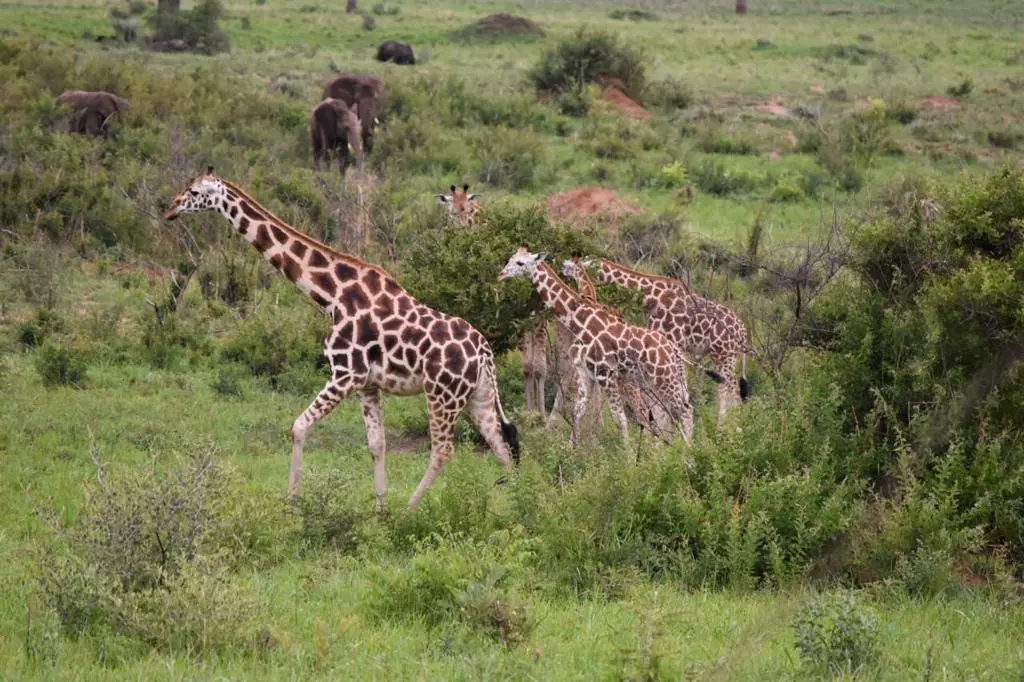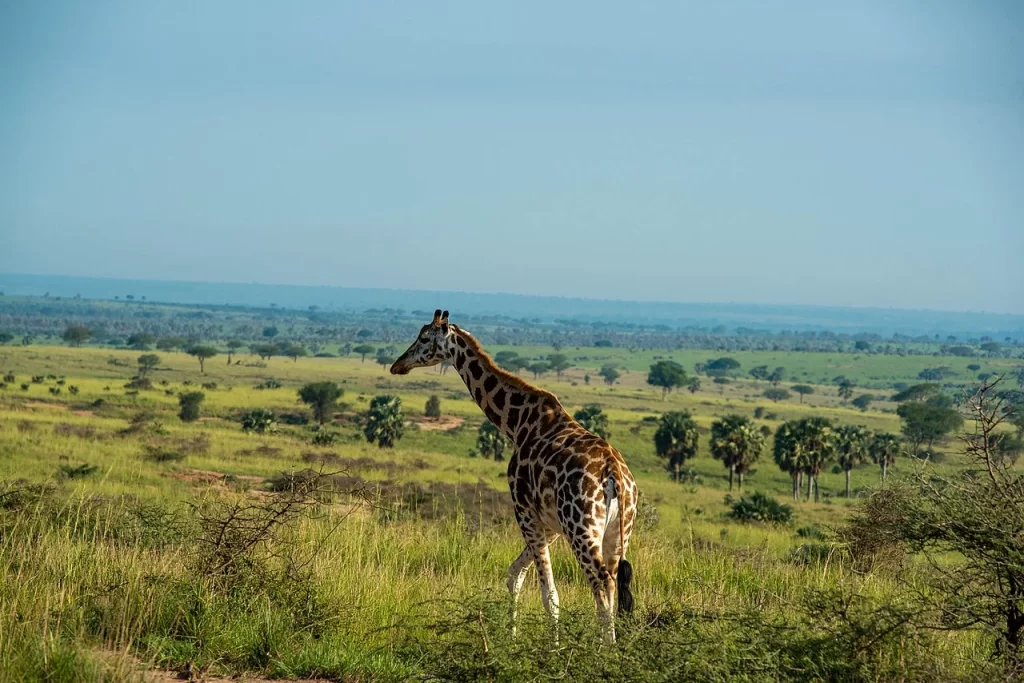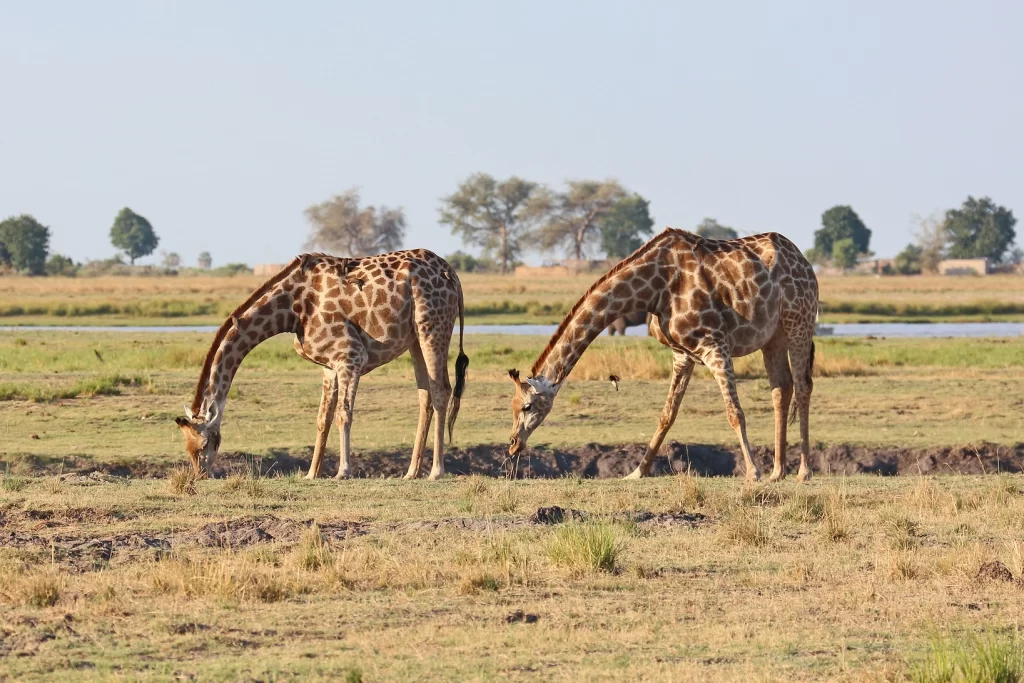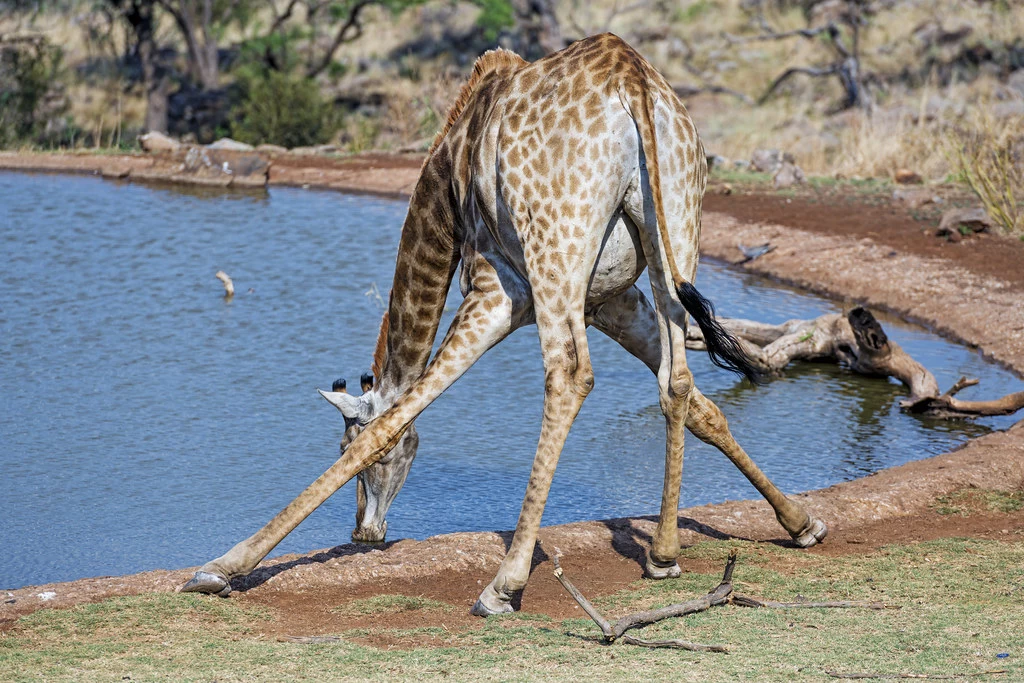Giraffes are the tallest land animal in the wild. They are herbivorous- they eat leaves and grass and browsers- they feed on higher vegetation. A giraffe can eat up to 34 kilograms of leaves in a day.
Giraffes mostly prefer acacia leaves but are also known to eat plants like myrrh, bush willows, and mimosa. They eat leaves, flowers, seeds, hay, or vegetables.
Giraffes also eat climbers, vines, and herbs. They also eat flowers when they are in season since they have more protein content. In captivity, giraffes are fed special formulated giraffe food in pellet form. Due to their height, giraffes feed on tree tops hence they have less competition for food except for elephants.

Acacia trees have thorns, which makes it hard for other animals to eat them. Giraffes have a long tongue which enables them to find their way around the thorns to the leaves. They are also known to adapt to the diet of the food that is available in the specific region they are living in and follow the climate patterns to change their food intake levels. Male giraffes are taller than the female ones, and so they feed at the tree tops leaving the lower branches for the females. A female giraffe’s food is richer in nutrients than that of male ones since their food mostly contains fiber and lignin.
Giraffes are ruminants – they regurgitate food and chew it again. They spend up to 18 hours of the day eating. They feed mostly in the morning and in the evening when the sun is cooler and spend the rest of the day chewing cud.
Giraffes also graze on grass, however, this only happens in extreme situations. Since they are so tall, they have to spread their legs wide apart and bend to reach the ground in order to graze on grass. This position leaves them vulnerable to predators, therefore, they graze in groups to avoid attacks. Giraffes also lick, eat and spit the bones of other animals to get nutrients like calcium.
Where Do Giraffes Live?
Giraffes are commonly found in grasslands, savannas, and open woodlands.
Due to their height and size, giraffes need more space to move around as they browse for food. This makes it hard for them to live in thick forests. The open grassland and savanna provide them with acacia trees which is their preferred feeding tree.

They also survive well in places with hot climates like the sub-Saharan areas. Some of the countries where giraffes are found in Africa are Tanzania, Kenya, Uganda, Chad, South Africa, Niger, Botswana, Zambia, Zimbabwe, Cameroon, Namibia, and Angola. Giraffes were known to be widely found in Africa but their population has reduced over the years. They are even extinct in some countries in Africa like Eritrea, Mali, Burkina Faso, Guinea, Nigeria, Mauritania, and Senegal.
There are different species of giraffes found across Africa. Each species is found in a different geographical area. The species are the Maasai giraffe, the Northern giraffe, the reticulated giraffe, and the southern giraffe. The Northern giraffe is found in Kenya, the southwestern side of Ethiopia, Congo, South Sudan, Namibia, Zambia, Chad, Cameroon, and Botswana. They live in savannas, bushes, and forests.
The Reticulated giraffe lives in both forests and savannas. They are found in the southern side of Ethiopia, Kenya, and Somalia. They are also called the Somali Giraffe. The Maasai giraffe is found in the savannas of Kenya, Ethiopia, Somalia, and Tanzania. They are also called the Kilimanjaro giraffe. The Southern giraffe lives in savannas, bushes, and forests. They are found in South Africa, Namibia, the South side of Botswana, Zambia, and Zimbabwe.
How Do Giraffes Get Their Food?
Giraffes are herbivores and ruminants. They get food from tall acacia trees and shrubs. They have adaptations that make it easy for them to reach the treetops and get food easily.

Giraffes have a 45 cm-long tongue with which they use to pull leaves into their mouths. Their long tongue also allows them to maneuver their way through thorny trees like acacia trees.
The giraffe’s saliva is thick and sticky and it helps to protect them from any thorns that they may accidentally swallow. Their saliva also covers the balls of food making swallowing and regurgitation easy. Giraffes also lack their upper front teeth which are replaced by a dental pad, which is a hard pad that the lower teeth press against to pull their food as they eat. They also use their canines to pull smaller branches as they strip their leaves. When they are resting, they regurgitate food, chew it again, and absorb more nutrients.
Male giraffes stretch to the top of the trees to eat the leaves there while the females reach for the lower branches of the trees and shrubs. Their long necks make it possible for them to reach treetops up to 5 meters long.
Do Giraffes Drink Water?
Giraffes mostly rely on the water in the leaves and trees they feed on. They are adapted to dry areas and can survive with very little water like camels. They can go for weeks with little to no water.

Their height makes it challenging when they need to drink water. To drink water, a giraffe needs to spread its legs and bend over 10 feet to reach the water. They need to spread their front legs and bend their knees.
Even when water is available in plenty, giraffes will not drink water daily. When they take water, giraffes drink a lot of water at one go, and this way they can spend long periods without taking water.
How Long Does a Giraffe Live?
Giraffes are one of the longest-living animals on land. This is because they only have lions and humans as predators. They are rarely preyed on because of their size and powerful hind leg kicks.
Giraffes can live for 20 to 25 years in the wild and 25 to 30 years, or more, in captivity.
Giraffes, unlike most other animals in the wild, survive for more years since they can defend themselves from no predators, In captivity, they are well taken care of, fed healthy with well-formulated food. Young giraffes are unfortunately targeted and killed by lions and crocodiles. Their chances of survival only increase when they live beyond 2 years.
Adult giraffes can protect themselves from predators with their powerful kicks and can also spot predators from afar because of their long necks. This makes them live for longer years than other animals.
